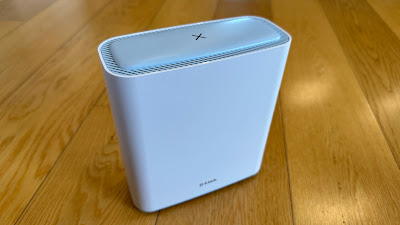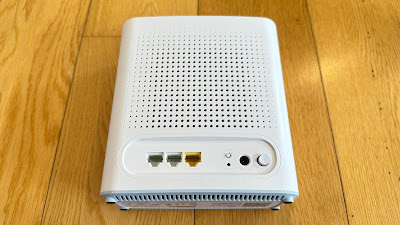Artificial Intelligence...
Sadly, it's become more of a marketing phrase than an actual scientific phenomenon. If you want your smart device to sound even smarter, you just claim it now uses AI to do whatever it does; better photos, more accurate tracking or perhaps a cleverer sound system.
That's not to take anything away from these gadgets - the tech built into things these days makes the Apollo space missions look like advanced kite-flying for kids. But there's a difference between something doing what it's been programmed to do and genuine "intelligence" - which I would define as the ability to assess each challenge as it presents itself and come up with a unique, creative solution.
Whether or not that's what D-Link's latest mesh Wi-Fi system is doing is hard to say.
The M32 AX3200 mesh system is D-Link's latest addition to its recently launched EAGLE PRO AI range of home-networking devices.
D-Link has certainly jumped on board the AI marketing train, claiming "AI-based Mesh capability with compatible AI Wi-Fi Extender or Router" as well as boasting an "AI-based Wi-Fi and Traffic Optimiser."
That certainly sounds like a lot of AI.
Don't let my anti-AI trash-talk fool you. The M32 is easily the most powerful edition of the EAGLE PRO family yet, especially when used in concert with one or two others (it's sold in a two-pack and a three-pack but is also compatible with the other EAGLE PRO routers and extenders).
The M32 units certainly aren't small; in fact, they're quite an unusual shape for a D-Link device - wide and tall yet not particularly deep - picking one up reminds me a bit of holding something like a first-aid kit, or perhaps a hard-cover dictionary. To follow that analogy through to its logical conclusion, if your Wi-Fi is in need of medical assistance, the M32 system is the dictionary definition of just the treatment you might need.
Apart from anything else, the sheer amount of coverage offered by the three-pack system I was sent to review is pretty standout; up to 740sqm - that's not just a big home, that's a big section.
This impressive super-king blanket of Wi-Fi is achieved in part thanks to the five internal antennae built into each unit - one of which is dedicated to monitoring which channels are most congested in your area so your home network can stay well clear of them. This is just one of the many ways EAGLE PRO devices achieve a less cluttered, more reliable connection to all the devices that need it.
While you can set up the M32 system using a web-based UI, that's nowhere near as fun (or as simple) as using the EAGLE PRO app. I've used this app and its strikingly similar predecessor, the D-Link Wi-Fi app more times than I can remember now and though I might be imagining it, I feel like the process has become more streamlined and therefore faster over the last year or so.
Probably all that built-in AI at work, I suppose.
Bear in mind, while the M32's can be used to extend an existing EAGLE PRO network, I've found you're actually just as well off creating a new one from scratch. Once you've set up the first unit as the primary router, the other two pair automatically. It was a little unnerving to discover this pairing process takes both the primary router and satellite unit offline as they automatically reboot - this is slightly different to how I've set up previous D-Link and EAGLE PRO devices. I guess the warning is, don't expect your Wi-Fi to stay on until all three units are powered up and initialised.
Another new feature on these devices is the status light. It's not new to have one obviously; most similar gadgets let you know when they're booting up, pairing and ultimately have a strong signal. The new thing about the LED's on the M32's is they're now in the shape of a single large cross on the top panel, rather than causing a more distracting blinking on the front. Thankfully, once again, D-Link lets you turn it off completely by digging into the primary router's settings via the app. This in turn deactivates the glowing cross on any satellite units too.
The only real downside of using one of the M32's as your primary router is its limited supply of Gigabit Ethernet LAN ports; only two as opposed to at least three or four on many other routers. These are useful for hard-wiring devices where a solid connection is essential - think your desktop PC or smart TV. The good news is, each M32 has a couple of ethernet ports giving you the benefits of that hard-line connection all round the house, without the inconvenience of having to run actual data cabling through your walls.
Perhaps most importantly of all, the whole EAGLE PRO range is Wi-Fi 6 enabled - this is the newer protocol that dramatically increases the number of devices that can connect to your home network simultaneously. As I've warned before, if you're upgrading from Wi-Fi 5, most devices will need to be reassigned to your new network manually even if you use the same SSID (network name). But it's well worth it. The extra speed and reliability more than makes up for the hassle of a few factory resets.
In previous reviews I've talked about the other technology D-Link uses to really optimise your home Wi-Fi experience; if you're not familiar with terms like Beamforming, MU-MIMO, OFDMA and TWT - don't get too bogged down in it all. Basically, these are all different ways the M32 units talk to each other and to their connected devices to ensure the clearest, most powerful and most reliable signal goes exactly where it's needed.
And it works. In fact, with the M32 system, it works better than ever. This is by far the strongest, fastest and most dependable EAGLE PRO network I've set up yet - an excellent option if you've got a large area to cover. While I'm still not convinced there's any genuine "Artificial Intelligence" at work here, there's no doubt these are very smart devices indeed.
Click here for more information and pricing on the D-Link EAGLE PRO AI M32 AX3200 mesh system.




No comments:
Post a Comment